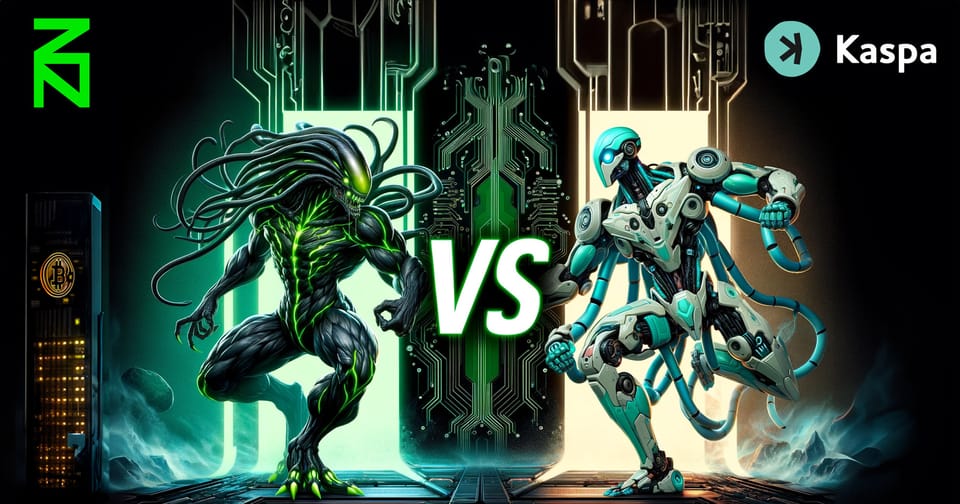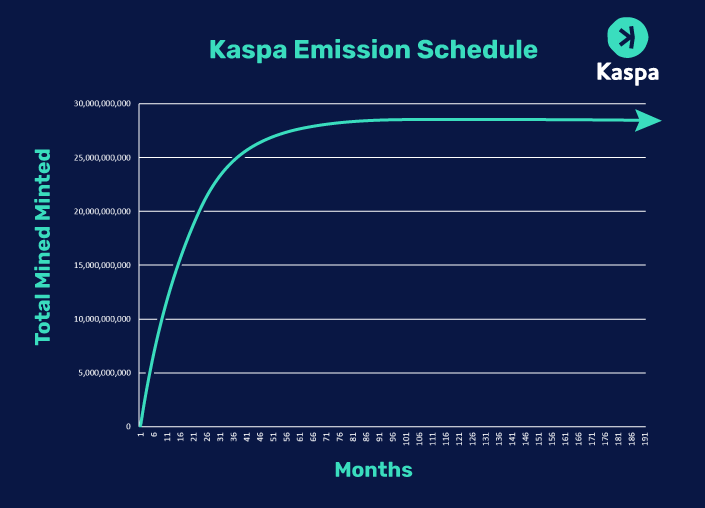Zenon Network vs Kaspa

(Any views expressed in the below are the personal views of the author and should not form the basis for making investment decisions, nor be construed as a recommendation or advice to engage in investment transactions.)
tl;dr Summary Comparison
| Compare | Kaspa | Zenon |
|---|---|---|
| Market Cap | 3 Billion | 20 Million |
| Tokens | $KAS | $ZNN & $QSR |
| Security | PoW | PoW & PoS |
| Protocol | GHOST DAG | Meta-DAG* |
| PoW Algo | kHeavyHash | SHA-3 |
| TPS Today | +/- 200 | 10** |
| TPS Roadmap | +/- 3000 | up to 100K |
| Transaction Fees | YES | NO |
| On-chain Governance | NO | YES |
| On-chain Venture Framework | NO | YES |
| On-chain Funding | NO | YES |
| BTC Merge Mining | NO | YES |
| BTC Scaling | NO | YES |
| Launched | 2021 | 2019 |
| Active Devs | 6 | >10 |
| Fair Launch | YES | YES |
| Community Run | YES | YES |
| Narrative | Replace $BTC | Complement $BTC |
| Ledger Support | In Development | In Development |
* The full meta-DAG has not been implemented yet: missing sentinels and virtual voting.
** Artificially capped until Dynamic Plasma is released. After implementation speed could increase to between 10 and 30 tps.
tl;dr Summary Discussion
In the dynamic blockchain ecosystem, Kaspa and Zenon Network emerge as two noteworthy projects, each with unique attributes. Kaspa, launched in 2021, has seen an exponential rise in market cap, reaching 3 billion in 2023. In contrast, Zenon Network, established in 2019, has also experienced significant growth recently, with its market cap reaching 20 million, indicating a promising upward trend.
Both networks were launched fairly, without preferential treatment to insiders or venture capitalists, and are driven by active community engagement. A distinguishing feature of Zenon Network is its on-chain governance, which democratizes decision-making among its users.
From a technological standpoint, Kaspa currently processes transactions more rapidly. Its shift to DAG KNIGHT from GHOST DAG is anticipated to further enhance its throughput by dynamically adjusting the DAG asynchrony. On the other hand, Zenon Network is developing its Meta-DAG, targeting up to 100,000 transactions per second through the implementation of Dynamic Plasma, Sentinels, and Narwhal & Tusk.
In terms of transaction fees, Kaspa operates with a fee-based model, whereas Zenon offers a "feeless" transaction system. Users on the Zenon Network can process transactions by generating proof-of-work (PoW) or fusing $QSR (plasma), potentially offering a more user-centric approach.
Funding and governance structures further set these networks apart. While Kaspa is supported through community grants, Zenon Network leverages an on-chain venture funding mechanism, Accelerator-Z, combined with its innovative on-chain governance, allowing stakeholders to directly influence protocol changes and receive compensation for contributions.
A significant aspect where Zenon Network stands out is in addressing the "rich get richer" problem prevalent in many Proof of Stake networks. By implementing a dual token economy, Zenon Network ensures a more equitable distribution of wealth and influence. This system mitigates the risk of wealth concentration, fostering a more balanced and inclusive ecosystem, a crucial advantage in the blockchain world.
Conclusively, while Kaspa demonstrates robust transaction speeds and strong community backing, Zenon Network distinguishes itself with advanced technology, a unique feeless transaction model, participatory governance, and an equitable dual token economy. These features underscore Zenon's potential for sustainable and inclusive growth in the blockchain sector.
Zenon Network
Zenon Network, the Network of Momentum (NoM), is a Layer 1 blockchain with several unique characteristics.
Zenon Network Layer 1 Properties
- Zenon Network is a Layer 1 meta-DAG with a dual token economy. It is secured by proof of work (PoW) and proof of stake (PoS).
- NoM was launched in March 2019 with a Bitcoin Talk forum post. The project was a fair launch, with NO tokens allocated to insiders, devs or VCs.
- The architecture consists of two separate ledgers (1) a block-lattice consisting of settled transactions, and (2) a meta-DAG that will contain the transactions required by the virtual voting algorithm. Sentinels, which relay messages, and virtual voting have not been implemented yet.
- The Layer 1 does not and will not have smart contract functionality. All smart contracts and scaling solutions will live on Layer 2 & 3 solutions.
- NoM currently processes 10 tps due to an artificial cap imposed in the code. Developers plan to deploy Dynamic Plasma in early 2024 which will remove the artificial cap and dramatically increase the speed. The Phase I roadmap includes deploying sentinels and Narwhal and Tusk (N&T). N&T separates the tasks of transaction dissemination from transaction ordering. If successful, NoM could see speeds increase up to 100,000 tps and will allow NoM to "move beyond" the blockchain trilemma.
- NoM features a dual token economy ($ZNN & $QSR). $ZNN is an inflationary asset which secures the network through lock-up by Pillars, Sentinels, and Stakers. It's also used by delegators to assign voting power to Pillars. $QSR is a complementary disinflationary asset which enables feeless transactions and is used to spawn Pillar or Sentinel nodes.
- Currently NoM emits 4,320 $ZNN and 5,000 $QSR per day. The total supply of $ZNN today (25 Nov 2023) is 10,394,860 with a max supply of 90,071,992. The total supply of $QSR today is 29,689,439 with a max supply of 90,071,992.
- NoM solves the rich get richer problem inherent in PoS networks by rewarding Pillars with $ZNN, which is not sufficient alone to launch more Pillars.
- NoM has an on-chain funding mechanism called Accelerator-Z. Community contributors can earn rewards through the funding framework.
- NoM looks to complement $BTC, not replace it.
Recent Development Progress
- Ledger integration is under development. Code was submitted to Ledger for audit. Check out the Ledger demo here.
- s y r i u s, the native wallet for NoM, features a best in class P2P swap experience. Users can swap assets P2P without a trusted intermediary.
- PTLC code is written and a PR was submitted. The code requires a rebase and community audit. PTLCs will bring privacy to transactions on NoM.
- Developers are working on a governance module that will allow Pillars to vote on protocol changes.
- The community recently deployed a trustless bridge to move ZTS token to and from Ethereum. There is no multsig with access to customer funds.
- The community is researching adding more wrapped assets, such as $zBTC and $zUSDT.
- Devs have cracked the code on Dynamic Plasma which will increase throughput and prioritize network congestion.
- Devs are exploring solutions where NoM could become the P2P mining infrastructure for $BTC.
- Devs are working on an EVM compatible Side Chain which will bring smart contracts to NoM.
- Devs are working on a robust mobile wallet for NoM. Check the status here. Developers need to complete the Dynamic Plasma design before the mobile wallet can be completed.
Marketing Process
- $ZNN and $QSR are currently only tradable on Uniswap and OTC within the s y r i u s wallet.
- Several CEXs have approached community members for listings, but for now the community has chosen to build volume on Uniswap.
- The HyperGrowth community marketing team is ramping up. They have a team of 20+ contributors who are working on performance marketing: zenon.org, twitter, attribution and much more.
- As of this writing (25 Nov 2023) the market cap for $ZNN is $20 million. By contrast, the market cap for $KAS is $3 billion (150x higher).
- If you want to explore Zenon Network, "Come Along with Me" and read more articles on zenon.info.
Kaspa
According to kaspa.org "Kaspa is the fastest, open-source, decentralized & fully scalable Layer-1 in the world." The world’s first blockDAG, Kaspa is a digital ledger enabling parallel blocks and instant transaction confirmation. "It is built on a robust proof-of-work engine with rapid single-second block intervals."
Kaspa Layer 1 Properties
- Kaspa is a community run, Proof of Work Layer 1 blockcain – completely open source with no central governance.
- The coin was fair-launched in November 2021 without pre-mining or any other pre-allocation of coins. The token is called $KAS.
- Kaspa was developed to solve the blockchain trilemma in the usage of digital assets: security, scalability, and decentralization.
- "Kaspa’s blockDAG network generates multiple blocks every second for posting transactions to the ledger. Combined with fully confirmed transactions in 10 seconds, this makes Kaspa ideal for everyday transactions."
- Where traditional blockchains appear as a simple linear structure, blockDAGs resemble a complex, interconnected web. Rather than chaining to singular blocks (as in normal blockchains), blockDAGs reference multiple predecessors and all tips of the graph structure, incorporating blocks from various branches instead of following a single, main branch.
- "Kaspa was designed to be hundreds of times faster than Bitcoin, with each Kaspa transaction visible to the network in one second, and each transaction fully confirmed in 10 seconds on average."
- Today, Kaspa utilizes the GHOST DAG consensus protocol. However, they are transitioning to a new protocol called DAG KNIGHT co-authored by Michael Sutton and Yonatan Sompolinsky. DAG KNIGHT sets the DAG asynchrony (k) dynamically to ensure the protocol can sustain a 50% attack. This will increase network throughput up to +/- 3000 tps.
- "Kaspa solves the scalability problem with its ability to generate and confirm multiple blocks per second. This comes with no trade-off to security and decentralization as seen with Proof-of-Stake networks."
- Kaspa charges fees to process transaction in order to prevent spam.
- Governance on Kaspa happen off-chain.
- The community supports the development and marketing of Kaspa through contributions from token holders. Kaspa does not have on-chain governance.
- Kaspa will enable smart contract on-chain through different Layer 2 scaling solutions.
- Kaspa has an "accelerated" emission schedule which attracted miners early during development.

Recent Development Progress
- Ledger integration is under development. Code was submitted to Ledger for audit.
- Devs are upgrading the consensus algo to follow the DAG KNIGHT protocol.
- Michael Sutton is rewriting the Kaspas node software from Golang to Rust. When complete developers believe Kaspa could process up to 100 blocks per second.
- Developers recently released a mobile Kaspa wallet to the App Store.
- Currently Kaspa prunes data older than three days and moves it to archival nodes. Developers are implementing P2P communication for archival nodes so old data is more available on block explorers.
Marketing Activities
- Kaspa has a robust community marketing team which runs a very active Telegram Group and Discord Channel.
- Kaspa is featured on many Crypto Youtube Channels and Twitter Spaces.
- Kaspa is listed on many exchanges and Binance recently announced they will be listing $kas soon.

Revisions
- 1 Dec 2023: Added link to https://t.me/zenonnetwork/274901 showing how NoM will compliment $BTC.

Member discussion